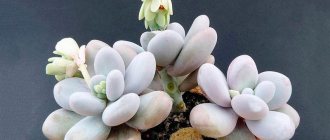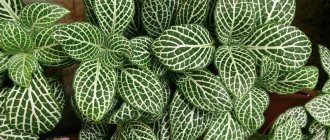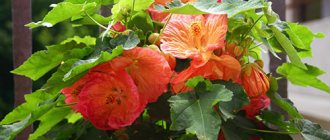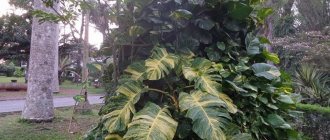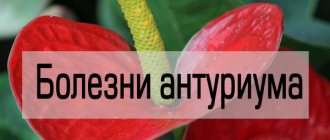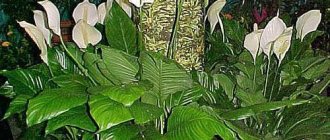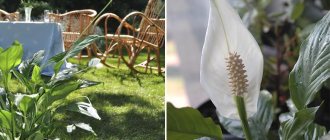Description of Anthurium
Anthurium Andre or Anthurium Andrianum are evergreen plants of the Araceae family. There are many varieties of them, approximately 900.
They have leathery foliage and come in different shapes.
The flowers are collected into a spadix. The cob has a leaf-veil. The bedspread comes in different colors and is heart-shaped . Attention! The plant requires quite careful care, it is difficult to grow at home; some types of flowers can only be grown in heated greenhouses.
Spathiphyllum and Anthurium: can they be kept together, signs and superstitions
Spathiphyllum and anthurium together would seem to be incompatible: after all, anthurium is a “male” flower, and spathiphyllum is a female one. However, in fact, they combine energetically (as the signs say), forming a kind of “yin and yang”, a harmonious combination of masculine and feminine principles.
If you have acquired both of these beautiful plants, you can watch each other’s flowers to understand how your partner or spouse is feeling: if the flower feels good, then everything is fine with the spouse, and if it withers, is sick, blooms poorly, then , time to pay attention to your loved one. However, it is better to always do this, without botanical tips.
Types and varieties with names and photos
Favorite
The plant is tall and has leathery foliage. The flowers have a pinkish veil, maybe salmon-colored. And the corolla is pale violet-red, it has a pink tip.
Silence
The bract is snow-white or pale cream, and the inflorescences are pale yellow. This houseplant has broad, dark green foliage.
The flower
cannot withstand strong light .
Leganza
The plant has oval foliage with pointed tips. The flowers are bright orange or yellow.
The bract is pinkish or coral in color, but with a green border.
Adrios Red
Has a scarlet coverlet.
Otazu
It has a bright yellow inflorescence and a dark red bract.
Champion
It has large leaves. And the bract is pinkish or snow-white.
Belize
The plant has an intense yellow inflorescence and a dark red bract with a greenish border.
Mix
This is a hybrid bred by crossing various varieties of anthurium.
Arizona
The plant has scarlet bracts and yellow inflorescences.
Florida
The plant has reddish-orange bracts that are green at the end.
Polaris
It has white-green bracts.
Minnesota
The bracts are scarlet, have a yellow border, and yellow inflorescences.
Acropolis
The bracts are snow-white.
Lunette
The bracts are soft pink, and the inflorescences are a deeper shade of pink.
Sensa
The bracts are purple and the inflorescences are dark purple.
Decorative flowering types of anthurium
There are over 500 varieties of anthurium in nature. There are about thirty species of them in indoor floriculture. Of the decorative flowering ones, two species are most often grown at home - Andre's anthurium and Scherzer's anthurium.
Anthurium Andre
Anthurium Andre
Anthurium Andre is an ornamental flowering plant - an epiphyte. It reaches a height of 1 meter. The stem is shortened, the root system is well developed. The leaves are dark green, leathery, oblong, on high petioles. They reach a length of 40 cm and a width of 20 cm. The peduncle is usually longer than the leaf petioles. There are many aerial roots on the shoot. The peduncle can be up to 15 cm long, the flower spathe is heart-shaped, glossy, with a metallic sheen, reaches 20 cm in length, and almost the same in width, 18 cm. It is also leathery, crinkled, bending towards the bottom. Often the bedspread is bubbly with clearly visible veins on it. The color of the bedspread ranges from white to bright red. The cob is up to 15 cm long and has a white or yellow color. Anthurium Andre does not have a pronounced dormant period. It blooms all summer, and with sufficient watering and good light it can bloom all year round. Moreover, adult plants bloom more abundantly than young ones, and only at home.
This may be interesting: Ruellia - home care
Anthurium Scherzer
Anthurium Scherzer
The main difference between this anthurium and the others is its small size and unusual cob. An unusual inflorescence is formed on a peduncle, sometimes reaching 50 cm in height . It is an elongated, spirally twisted spadix of orange-red color, up to 8 cm long. The spathe surrounding the inflorescence is usually thick, almost round in shape, and bright orange. As we have already written, Scherzer’s anthurium stands out from the rest with its miniature size - it grows no higher than 30 cm. The stem is green, short, up to 15 cm in height, but thick, up to 2 cm in diameter. Anthurium Scherzer has magnificent leaves: leathery, pubescent on both sides, dark green in color, oblong with a pointed end. The leaves are up to 26 cm long and up to 6 cm wide. The petioles are shorter than the leaves. Imagine that up to 8 flowers bloom at once in a flower pot, and they last an amazingly long time - up to three months! The flowers exude a pleasant aroma.
Anthurium Scherzer is an unpretentious flower to care for at home, so breeders are developing more and more new varieties of this elegant flower. They learned to produce variegated varieties, speckled and twisted in a spiral with several curls.
Based on the color of the veil of Scherzer anthurium flowers, three groups of varieties can be distinguished: red anthurium, green anthurium and pink anthurium.
Anthurium Red
We can recommend Anthurium Red to novice gardeners. It blooms for several months. Its bright red, magnificent flowers will lift your spirits, and if you follow the basic rules of caring for it, anthurium will delight you with its beauty all year round.
Another anthurium that is very popular among gardeners is Amaretti. You will recognize it by its white inflorescence with red spots. His bedspread is multi-colored, combining red, orange, yellow and green colors. This is a new variety, but has already gained popularity for the beauty and duration of its magnificent flowering.
Anthurium Amaretti
All indoor anthuriums are perennial plants. Breeders have developed many varieties of flowering anthuriums with purple, burgundy, white and even black flower covers. But the most common color is bright red. The smell of anthuriums of different varieties is also different, but all of them have a pleasant smell.
This may be interesting: How to recognize pests on violets and what to do with them
Transfer
Prepare a new pot with drainage holes and fill it with soil.
Before transplanting, water the flower thoroughly, then the soil will be softer and the root will be easier to remove from the container. If you have a plastic pot, you can lightly tap it on something hard.
Afterwards, the anthurium is removed, inspected and placed in a new pot.
Important! Replanting is required if roots are visible from the drainage holes and on the soil surface. It is better to choose a pot that has the same height and diameter.
If you transplant a flower into a pot that is too spacious, you will wait a very long time for the anthurium to bloom, since it will not form flower buds until the roots grow into the new soil.
After transplanting, the flower is watered again, and sphagnum moss is sprinkled on top.
Plant names
In indoor plant growing, anthurium is called “male happiness.” It is believed that if an unmarried woman gets such a flower, she will soon meet her betrothed. There is also an opinion that anthurium can help men with sexual problems.
Another name for the flower is “family happiness.” In families where anthurium appears, mutual understanding and harmony will reign. You can pair it with a plant called “female happiness,” spathiphyllum.
Home care
Lighting
Anthuriums require diffused lighting; the flowers tolerate partial shade well. Therefore, they need to be shaded from the sun's rays. Window sills in the east and northwest are perfect.
Temperature
In summer, the optimal air temperature for them is +20-28°C, but not lower than 18°C. And from the beginning of autumn to February, a temperature of +15-16°C is suitable for them.
But one variety of anthurium requires lower temperatures, the plants are called Scherzer anthurium hybrids. And in winter they are kept for 6-8 weeks at an air temperature of +12-16°C, during which time watering is reduced.
If you need the plant to bloom earlier, then in January the temperature is gradually increased to +20-25°C.
Watering
Water the flowers abundantly, but make an interval between waterings and wait for the top layer of soil to dry. But it is impossible for the lower layers of the earth to dry out.
Important! The flower is watered approximately once every 4 days with soft water at room temperature.
In order for the anthurium to bloom in winter, at the beginning of autumn, watering is gradually reduced, the relative air humidity should be 80-85%, and the air temperature +16-18°C.
Water the flowers with soft rainwater . If you water with tap water and lime, soften it.
Do not over-moisten the soil, as the plant's roots may rot. Also, do not allow the water in the pan to stagnate. After watering, immediately pour out excess water from the pan.
Soil and fertilizers
Make a substrate by mixing 2 parts humus, 1 part leaf soil, 1 part peat soil and 0.5 sand. Next, 15% of cones, charcoal, and sphagnum moss are added to the substrate to give the soil greater lightness and breathability. Anthurium requires slightly acidic soil with pH = 5.5-6.5.
Another substrate option is to mix equal parts of soil for flowers and special soil for orchids.
And also add sphagnum moss.
A mixture of sphagnum moss, peat soil and coconut fiber works well.
From the beginning of spring to the end of summer, anthurium is fertilized once every 2 weeks. First, in the spring, a weak solution for decorative deciduous plants is used for feeding, and after 2-3 such feedings they switch to others: Agprikola, Fertika-lux.
especially need fertilizing before the buds open . In winter, the plant is stopped fertilizing.
Possible difficulties
If you notice:
- spots on stems and foliage;
- wilted foliage;
- the plant does not bloom, its growth is slow.
This can happen due to excess moisture, improper soil composition, insufficient soil breathability, diseases or pests.
You need to water the plant and remove it from the pot. Remove the old soil, carefully examine the roots; if they are damaged or have begun to rot, then cut off the rotten areas and treat the wounds with charcoal powder.
Also inspect the stem and leaves, remove dried or yellowed leaves, cut off inflorescences and flower stalks. If signs of rot are visible on the plant, treat the flower with a fungicide.
Plant the plant in new soil and a new pot.
This video contains detailed and valuable tips on how to avoid possible problems with growing anthurium:
Why doesn't it bloom
- To flower, the plant must be kept in a room with a temperature of at least +18°C.
- The flower should not be placed in direct sunlight. The flower really does not like drafts.
- It is necessary that the volume of the pot be slightly larger than the volume of the roots, otherwise the plant will not bloom.
- Don't forget to fertilize the plant.
